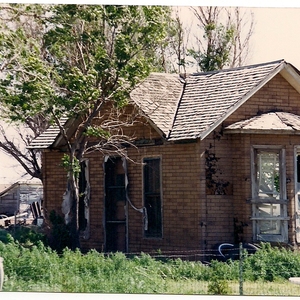How can I clean painted brass door knobs. I scraped a little but realized it was scratching the brass and stopped. I considered a fine wet sandpaper, but thought someone might know of a product to technique that was better and safer. Thanks.
Discussion Forum
Discussion Forum
Up Next
Video Shorts
Featured Story

Fine Homebuilding is excited to be the official media partner of the 2024 Building Science Symposium series! This event offers builders, tradesmen, architects, designers and suppliers to discuss topics ranging…
Featured Video
How to Install Exterior Window TrimHighlights
"I have learned so much thanks to the searchable articles on the FHB website. I can confidently say that I expect to be a life-long subscriber." - M.K.

















Replies
I have an old, cheap grinder that I use for just this purpose. I use a fine wire wheel on one side, with a cloth buffing wheel on the other side. I took off all the guards and shrouds, and free hand the stuff on the bottom side of the wheel. I use a pliers to hold small parts like screws.
If the hardware is really caked with paint, it's best to soak it in stripper first, wipe off most of the sludge, then use the wire wheel to clean it up.
The buffer will remove the faint scratch marks from the wire wheel, and you can bring the brass up to whatever sheen level you want, depending on the polishing compound you use.
Be sure to wear eye protection in this operation. The individual wires on the wheel shed regularly and often head directly to your face.
Had a similar situation with brass fittings that had been painted a thousand times.
TSP in boiling hot water and then let them set for a day or two. The paint crinkled, and softened. I was able to remove about 80% with a plastic knife, plastic so I didn't scratch the surface, used as a scraper. The paint came off in big chunks.
Repeating the boiling water and TSP got the majority of what remained. A good polish with a soft cloth and a scraping the few rough spots got the tiny bit left.
Advantage with this was that some of the paint was likely lead based and soaking it off limited my exposure and any spreading. It also didn't need any harsh chemicals. TSP is cheap.
Why not just use paint stripper? The citrus based stuff works pretty well, smells better than MEK and dries slower, so you don't use as much.
"I cut this piece four times and it's still too short."
I had TSP for cleaning paint brushes, water an old pot and a stove handy. I went with what I had and it worked. Lets just say I'm cheap. No need to spend more money than necessary.
I'm with you. But I just boil them without any additives. I've cleaned all kinds of old hardware this way with no problems and no toxic chemicals to deal with. It's the most Earth friendly approach I've seen and used.
Hmmm. Hadn't thought of just plain water. Might go with that next time.TSP is fairly benign. But your right to be careful. The phosphates have to be used in limited quantities, never more than necessary, and kept out of waterways where they can cause algae blooms and possible fish kills. Even short of this extreme it won't do anything, environment wise, any good. Same with any chemicals and wastes.
Soak them in Lacqure(sp?) thinner, the paint will just melt off. No scratching of the brass.
"Goof Off" or "Poly Clens" will soften most paints and allow you to clean them off with an old teflon-pot scrubber.
Phill Giles
The Unionville Woodwright
Unionville, Ontario
brake fluid...
Life is not a journey to the grave with the intention of arriving safely in a pretty and well preserved body, but rather to skid in broadside, thoroughly used up, totally worn out, and loudly proclaiming
WOW!!! What a Ride!
I see you got the brake fluid in there. I've tried a dozen different ways (though IMERC didn't tell me about brake fluid until last week, so I haven't tried it yet). If you have a lot, you can soak them in a combo of half water half amonia for about 3 days and the paint falls off the brass under running water (most of the time). I tried the TSP and it didn't work for me at all, but ruined a pot which got the wife pissed off at me. (Not my good pot, you idiot!!!) Rock mirable works really well, but you have to put it on the pieces individually so it's a pain when you have a lot of brass.
A bench grinder with a polishing wheel and good compound is needed either way. It takes off the paint remnants that don't come off with solution and gives the brass the polish you'll need afterwards. And just hold the screws in your fingers and polish the heads. Pliers can damage the threads, and real men aren't afraid to polish a finger or two. I've stripped and polished every piece of hardware in a big old manor house this way, and there's nothing better than seeing it when it's done. It looks like a million bucks. And I hate painters who paint hardward. I just hate them. And I'm not too fond of other painters, either.
SHG
Didn't I mention TSP attacks aluminum? Ummm ... Sorry. Kinda slipped my mind.
For heavens sake, just use paint stripper. I was a 'stripper' for the first three years of my being in the trades but had to stop for health reasons, long term exposure to the stuff is baaaad. Just get some Zip Strip, put the fixtures in an old pan (bread pans worked well for door & window hardware), pour stripper over the hardware so it just covers it, put saran wrap over the pan and let it soak for a few hours to a day. You come back to it, (wear rubber gloves) and get a toothbrush or a small nylon scrub brush and have at it. Rinse it off with water and keep brushing away till its all removed. After the initial coat is off you may need to recoat it to get residue off or paint that still is in the crevases, but the main thing is is to keep it wet with stripper, don't let it dry out, otherwise the stripper has lost it's effectivness. If you can't remove the hardware then buy some 'Peel Away' type stripper where the object gets covered with a type of blanket and is left to soak. Do not use any type of scraper or steel wool on brass unless you want to destroy it, "age" it, or dull the finish to a satin.
Do not try to heat gun or burn paint off of any type of metal. It won't work, because it will heat the metal and the paint just readheres to the hot hardware . A heat gun is usually the best thing for getting the initial layers of old paint off of wood. You have to do it for a while to get the hang of it and not char the wood, but once you do, it goes very fast and the results in most cases are immediate. After the heatgun you go back with the stripper and steel wool off the residue, it's less of a mess. Whether you use heatgunning or paint stripper always make sure where you are working in a well ventilated place, if you can bring the project outside that is the best, but if you are inside you should wear an organic filter resperator (about $45) which is charcoal activated. They're a pain but believe me they're worth it. Good luck.
What everybody else says, plus: if it is only small spots of paint sometime just some oil (4in1, even vegetable) will soften the paint enough to scrape if off with a plastic tool or your fingernail. This works well for very worn brass/bronze, where a stripper of any sorts might mess up the patina, or even take off some of the metal coating if your hardware is cheap, not solid brass.
Sometimes just water is fine, too, but with the struff I have at home (unfinished, very weathered bronze and sometime just plain steel) leaving them in water long enough to soften the paint will lead to rust!
Tsp in boiling water is excellent if there is a lot of paint; citristrip is excellent, too, I would always choose it over zip strip. Never had much luck with Peel Away, too mild for the nasty enamel I always have
Edited 11/20/2004 9:33 am ET by RickD
I just use baking soda, boiling water, and old pot with a cover (never use it for cooking again). Drop in the brass knobs, cover and let sit outside the back door for an hour or two. Don't let it completely cool.
Take an orange stick (the kind us wimmin use on our cuticles...available at any drug store) and use it to "encourage" any stubborn paint left on the knobs. I find that the paint just peels off on its own in the hot water.
Easy, cheap, doesn't hurt the brass, requires no fancy chemicals or tools.
We make "hardware stew" quite often. Lots of painted hardware in the house.
jmo's method also works for plated materials which would lose the plated finish using the harsher alternatives....that's not a mistake, it's rustic
Soak it in Pinesol, weird but it works
Let's not confuse the issue with facts!
brian,
Goof Off...not the second version.(The smelly one, petroleum one) Sop up a rag, and go for it!
Peace